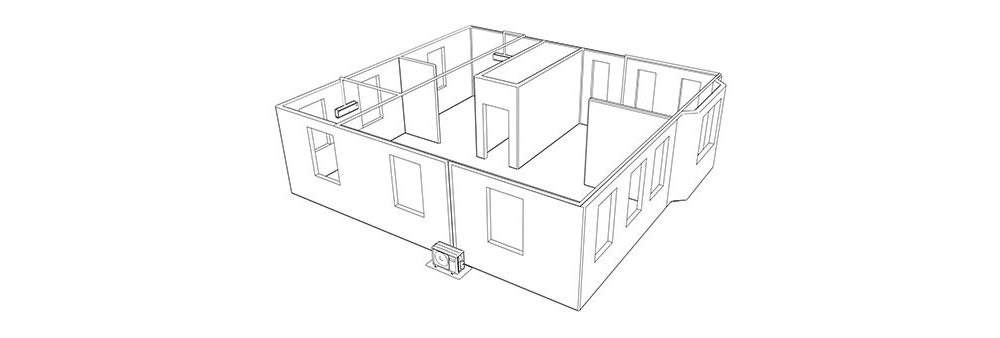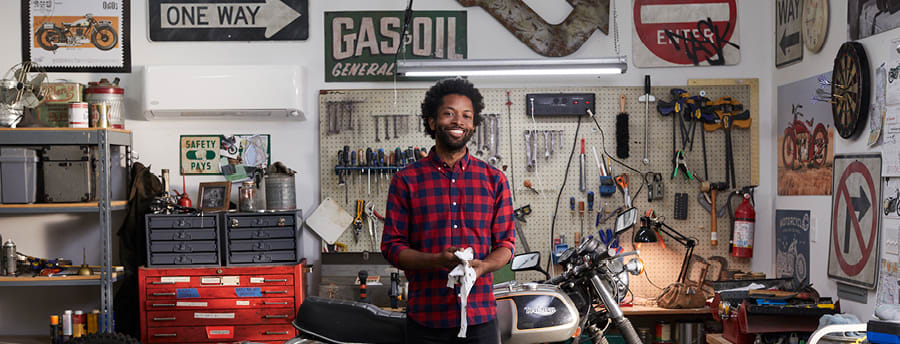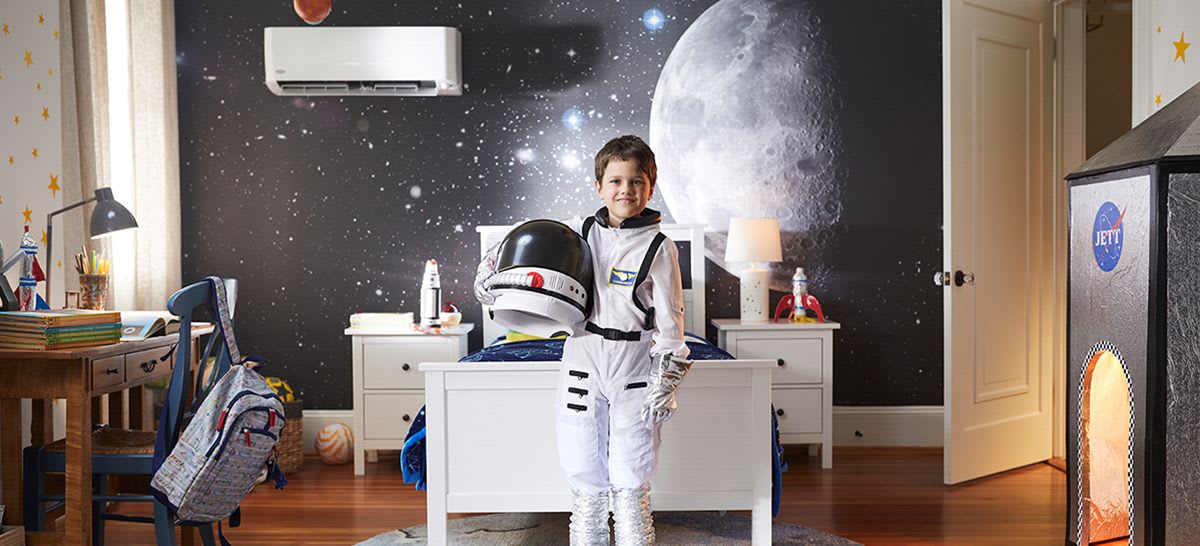Are Mini Splits Efficient?
Ductless mini split systems are gaining momentum as a great source for heating and cooling comfort. And if you are asking yourself, “are mini splits efficient?” you’ve come to the right place. This page will explain everything you need to know about how energy efficient ductless mini splits are, how they operate, how they compare to central heating and cooling, and their pros and cons. For information on pricing, you’ll need to check out the content available on our ductless air conditioner cost web page.

In many ways, ductless mini split systems are similar to central air conditioning and heat pumps. Both types of systems include, at minimum, an indoor and an outdoor unit that are connected by tubing that allows chemical refrigerant to flow between the units to create the heat transfer needed for heating and cooling.
The big difference between the two systems is how heated or cooled air is distributed. With central air, there is one “centrally” located indoor unit with a larger evaporator coil and a powerful blower that sends conditioned air out into the various rooms in the home through a series of air ducts. The indoor unit is often installed in a basement, utility closet or even in the garage – away from most of your living spaces. The indoor unit is sized to provide heating or cooling for the entire home.
With a mini split system, the indoor unit is installed in the room that needs heating or cooling. It has a smaller evaporator coil and a smaller air handler that blows heated or cooled air directly into the room. The indoor unit is sized to meet the heating or cooling needs of the room in which it is installed. You can easily zone a mini split system by adding an additional indoor unit for each space that needs heating or cooling. The number of indoor units allowable will depend upon the capability of the outdoor unit. If needed, you can add a second outdoor unit. The ductless system is often managed with a remote control.
Are Mini Splits More Efficient Than Central Air?
Ductless mini split units often achieve higher SEER ratings than central AC units and heat pumps. The highest published efficiency rating of a top-of-the-line Carrier split system air conditioner actually compares with a mid-level Carrier ductless mini split model. So, why are mini splits more efficient than central air? That’s a complicated question, so let’s start by looking at how central air systems work.
Central forced-air systems typically include one outdoor air conditioner or heat pump unit and one indoor unit – usually either a combustion furnace or electric fan coil. Heated or cooled air circulates to the various rooms in your home through ductwork hidden behind your walls. As the heated or cooled air travels through the ductwork, it loses some of its heating or cooling energy – and results in a loss in system efficiency as well. Poorly installed, leaky, and poorly insulated ductwork can lead to even more energy loss. And because a central air system is designed to provide comfort for the entire home -- regardless of how many rooms are being occupied -- they often create cooling or heating for rooms that may not really need it at the time.
To combat this, you can create zones within the home that are on different temperature schedules However, depending upon the number of zones and other factors, zoning your home typically requires the installation of airflow controlling dampers within the duct system, a specialized control board that manages zoned temperature control, a zoning-capable thermostat (or a separate thermostat for each zone), and possibly even additional outdoor or indoor units. As you may imagine, the cost for installing a zoned central air system will be higher than a standard system.

Ductless mini splits are designed to provide more targeted comfort because they require an indoor unit for every area that needs cooling or heating. The indoor unit can be a wall mount, under-ceiling mount, in-ceiling mount of floor mount model. If you only need comfort in one room – for example in a room addition, or providing comfort to a room your central AC system struggles to keep cool – only one indoor unit is required. If you are outfitting your entire home with ductless units, you can enjoy comfort in the areas that are occupied while leaving unoccupied areas either turned off or “set back” for energy-saving temperature control. Regardless of the number of indoor units, each one delivers cooled or heated air directly into the room, so you don’t have energy lost traveling through ductwork. In addition, ductless outdoor units typically include an inverter-controlled variable speed compressor which can deliver higher SEER and HSPF efficiency ratings than standard versions. Inverter controls can adjust operation so that the system provides the precise amount of heating or cooling capacity needed for comfort. Without the inverter or variable-speed capabilities, the system would cycle on at full capacity regardless of how much output is actually needed for comfort.
Pros and Cons of Mini Split Efficiency
Naturally, each type of system has its pros and cons. Let’s take a closer look at mini split efficiency and see the advantages and disadvantages as compared to a traditional forced air HVAC system.
Mini split efficiency: Pros
- Higher SEER and HSPF ratings: With mini split heat pumps and air conditioners, you’ll find higher SEER (cooling efficiency) and HSPF (heating efficiency) ratings. For example, a Carrier Infinity® system mini split air conditioner offers a published rating of up to 42 SEER cooling efficiency compared to a top-of-the-line Carrier Infinity split system air conditioner that provides up to 26 SEER cooling efficiency. Keep in mind that, just like miles-per-gallon for your car, a higher SEER number means higher fuel efficiency.
- Targeted comfort: Mini split systems can provide more targeted comfort. They are perfect for adding comfort to a room addition or to a room in the house that your central air system can’t seem to keep comfortable. Or, you can create a zoned system for your home by adding a mini split indoor unit in every room. In terms of energy savings and efficiency, you can save money on utility bills by setting the temperature for comfort in rooms you are using, and either turning off or setting back temperatures in the rooms that are unoccupied.
- Avoid energy lost through ductwork: Because ductless systems deliver comfort directly from the source to the room, they eliminate the energy – and money – lost by central air systems as cooled or heated air travels through ductwork into your living spaces. In an average house, you can lose 25% or more of your energy through the ducts.*
- Easy system installation: While installation costs don’t necessarily affect the system’s energy efficiency, they do add to the overall cost of ownership. Installing a ductless mini split system in a room or home without ductwork can save on costs associated with installing new ductwork and connecting to existing duct systems.
Mini split efficiency: Cons
- Aesthetics: Because a mini split indoor unit is often either wall mounted, ceiling mounted or floor mounted, it may negatively alter the aesthetics of the room. And, you can’t “hide” the unit by putting a plant in front of it because you will block the flow or heated or cooled air into the room.
- Maintenance: All HVAC systems require periodic maintenance to operate at their best. While many central air filters can last up to three months or sometimes longer, ductless mini split filters must be cleaned every month. The fans in ductless systems just can’t handle the accumulating dust or debris. And if you skip the monthly cleanings, you’ll likely incur costs both related to loss of efficiency and a potential service call. If you have multiple indoor units, you’ll need to make sure each unit’s filter is being maintained.
- Multi-unit, whole-home installation: If you are attempting to outfit your entire house with ductless mini splits, be aware that you will need multiple indoor units – which means added upfront costs for both equipment and the labor to install. The finished system will provide years of money-saving comfort, but installing a central air system with just one indoor unit and one outdoor unit may cost less for both equipment and labor than a whole-home ductless system. And, if you are installing a ductless heat pump system in a colder climate, you may also incur the additional cost of a backup heat source.
For more information comparing mini split vs central air systems, check out web page dedicated to that subject.
Can a Mini Split Work for More Than One Room?
Ductless mini split comfort systems are an efficient and effective alternative to traditional central air. So, can a mini split work for more than one room? The answer is yes, but keep in mind a few key details. First, each separate space will need its own indoor unit. Depending on how many indoor spaces you have, one outdoor unit may be adequate. However, for larger homes, you may need an additional outdoor unit as well to accommodate the number of indoor units required. Second, the indoor units will need to be sized individually to handle the heating or cooling capacity of each specific room. “Sizing” in heating and cooling refers to how much heating or cooling in BTUs (British thermal units) per hour, or BTU/h. For smaller rooms, a 9000 BTU or 12,000 BTU unit will probably work. Bigger rooms, or rooms with more windows or less insulation may require a larger capacity unit.
If you are asking “how big of a mini split do I need?” you probably need to contact your local Carrier dealer for an accurate answer. A qualified HVAC professional can assess a room or home and take into consideration the many variables involved in calculating the correct heating or cooling capacity needed to keep your home comfortable. And, as previously discussed, if you are considering a multi-room installation, each area will need to be evaluated separately.
Carrier's Highest SEER Mini Split Systems

Mini split ductless systems are recognized worldwide for their energy efficiency. Our highest SEER mini split system unit, from our Infinity system series, offers exceptional efficiency rated up to 42 SEER. As a comparison, our most efficient forced air Infinity system mini split air conditioner provides up to 26 SEER cooling efficiency. Additional mini split systems from Carrier include our Performance™ series models rated up to 25 SEER and our Comfort™ series units rated up to 19.8 SEER.
SEER is an acronym for Seasonal Energy Efficiency Ratio. It is a universal rating system for cooling systems – much like miles per gallon (mpg) for your vehicle. SEER is calculated by taking the total amount of heat removed from a space during the cooling season divided by the total amount of electrical energy consumed by the air conditioner during the same time frame. The U.S. Department of Energy (DOE) sets the minimum SEER requirement an air conditioner must provide. The DOE also sets standards for recognizing high efficiency models as a part of their ENERGY STAR® program. Appliances and products that meet the ENERGY STAR requirements stand above others for their ability to conserve energy and save money. All of our Infinity system ductless mini split units are ENERGY STAR certified.
Explore Carrier's Most Efficient Mini Split Systems

Carrier’s most efficient mini split system combines our 38MPRA outdoor unit with our 40MPHA high wall indoor unit and offers an efficiency rating up to 42 SEER. While it may be tempting to simply ask for the most efficient system, remember that a qualified HVAC technician can assess the size and layout of your home and suggest an appropriate solution for your budget and comfort needs.
Keep in mind that a higher efficiency system will typically include a higher initial cost compared to a mid-efficiency or a minimum efficiency system. Your dealer can provide approximate energy cost projections for different types of systems along with a cost estimate for the equipment and installation. Then, you can decide for yourself which system will pay off in the long run. For example, if you are not planning to stay in place for a long time, you might choose a more budget-friendly option. Or, if you are considering staying in place an extended period of time it might make sense to invest in the highest efficiency option you can afford.
Interested in locating an experienced HVAC technician you can trust? If so, find a Carrier expert to learn more about ductless mini split systems.
Check out this article and discover what is Ductless AC
* https://www.hgtv.com/design/remodel/mechanical-systems/is-ductless-heating-and-cooling-right-for-you
- Can you install a ductless air conditioner for garage?
- Learn how to install a mini split system
- Read about mini split maintenance
- Learn about mini split repairs.
- Read about mini split pros and cons
